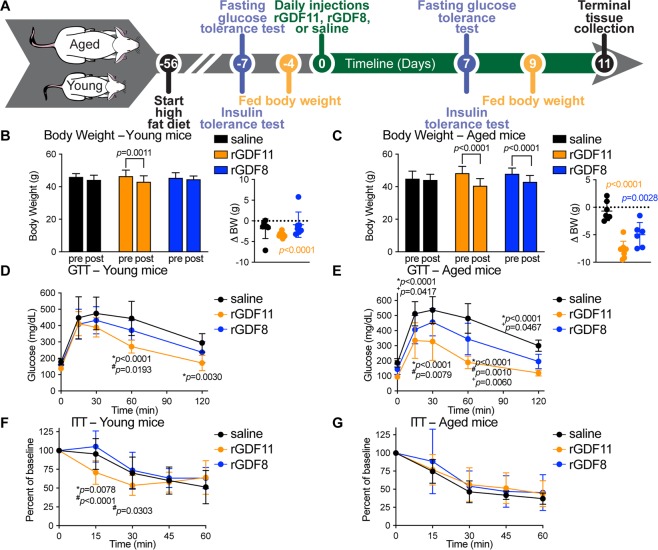Figure 2.
Exogenous administration of rGDF11 and rGDF8 to mice fed a HFD results in reduced body weight and significantly improved GTT performance. (A) Schematic representation of treatment schedule and analyses performed on young and aged mice fed a high fat diet. (B,C) Fed body weights and relative weight loss (inset) in young (B, n = 7–8 mice/treatment) and aged (C, n = 6–8 mice/treatment) mice were measured prior to treatment (pre) and after (post) 9 days (D9) of treatment with saline (black), rGDF11 (orange) or rGDF8 (blue). Inset: the color of the p-value corresponds the to the group compared (black: saline; orange: rGDF11; blue: rGDF8). (D–G) Glucose tolerance tests (D,E; GTT) and insulin tolerance tests (F,G; ITT) were performed on young (D, n = 7–8 mice/treatment; F, n = 8–9 mice/treatment) and aged (E, n = 6–8 mice/treatment; G, n = 7–10 mice/treatment) mice. For GTT, mice were fasted for 18 hours overnight before a bolus of glucose was administered (2 g/kg). For ITT, mice were fasted for 5 hours before injected with 1.0 units/kg of insulin. Data information: In (B–G), data are presented as mean ± standard deviation. For (B, C), 2-way ANOVA with either Sidak’s or Tukey’s post hoc test was used for comparison between pre vs. post treatment or comparison between groups, respectively. For the insets, an unpaired Student’s t-test was performed for comparison between pre vs. post treatment. For (D–G), 2-way ANOVA with Tukey’s post hoc test was used. For all graphs: * - saline vs. rGDF11; # - rGDF11 vs. rGDF8; + - saline vs. rGDF8.

